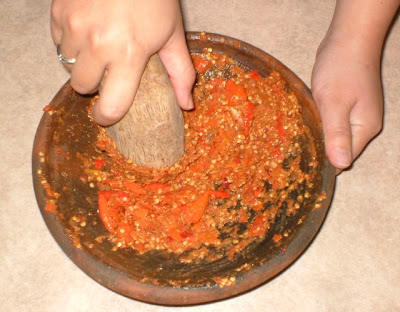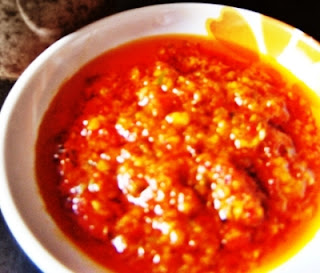The word Sambal is of Indonesian origin. It is a condiment, an ingredient or a dish which always contains a large amount of chilies. Sambal is popular in Indonesia , Malaysia , Singapore , the southern Philippines and Sri Lanka , as well as in the Netherlands and in Suriname
Some ready-made sambals are available at food markets or supermarkets in many Asian countries.
Some popular Indonesian sambals include sambal terasi (shrimp paste sambal), sambal bajak, sambal mangga (green mango sambal), sambal ijo (green sambal), sambal balado, sambal kecap (sweet soy sauce sambal) sambal ulek, sambal setan, sambal Taliwang, sambal matah and many more.
Sambal Terasi
A common Indonesian style of sambal. Terasi (shrimp paste) is similar to the Malaysian Belacan, but with a stronger flavor since terasi is a more condensed shrimp paste than belacan.
Sambal Bajak
Chili (or another kind of red pepper) fried with oil, garlic, terasi, candlenuts and other condiments
Sambal mangga
Freshly ground Sambal Terasi with shredded young mango; this is a good accompaniment to seafood.
Sambal ijo
A specialty of the Padang area from Indonesia
Sambal Balado
This is the Padang
Sambal Kecap Manis
Indonesian sweet soy sauce, chili, shallots and lime it has a chiefly sweet taste, as said by the Indonesian word 'manis' which means 'sweet'.
Sambal Ulek (Oelek)
Chili (bright red, thin and sharp tasting). Some types of this variant call for the addition of salt or lime into the red mixture. Oelek is a Dutch spelling which in modern Indonesian spelling has become simply Ulek; both have the same pronunciation. Ulek is Indonesian special stoneware derived from prehistoric household kitchenware that is still being used actively in most Indonesian kitchens, particularly in Java. It is a stone pestle (called ulekan) with a mortar (ulek-ulek) made from an old and matured bamboo root, that is used for crushing chilies, peppers, shallots, and other kinds of ingredients.
Sambal Setan
A very hot sambal with Madame Jeanette peppers (red brownish, very sharp). The name literally means "Devil's Sauce".
Sambal Taliwang
This variant is native to Taliwang, a village near Mataram, Lombok Island , and is made from naga jolokia pepper grown specially in Lombok mixed with garlic and Lombok shrimp paste. It is served as condiments to ayam bakar Taliwang (Taliwang grilled chikcen)
Sambal matah
Raw Shallot & Lemongrass Sambal of Bali origin. It contains a lot of finely chopped shallots, chopped bird's eye chilli, shrimp paste (trassi), with a dash of lemon.
Basically, there is no fix standard recipe for sambal. People make it according to their own preference. Some like more fiery sambal, some like the less spicy one. Some like it more sour and some more sweet.































